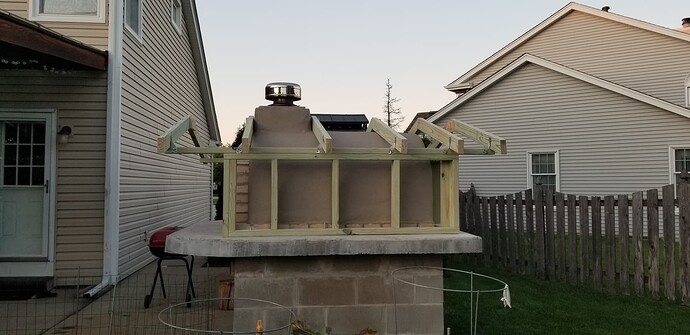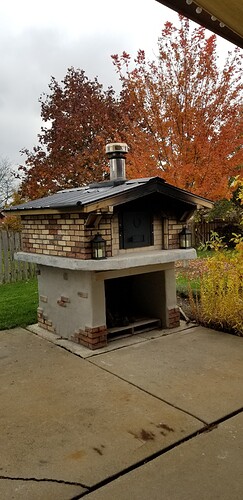Made an oven and decided to paint it and not apply brick veneer. Used exterior house paint, I thought I read some where that was okay. We were so happy with it…until it started raining. Being that it’s Oregon, it rained a LOT and ALL winter. The floor of the oven was completely wet and we couldn’t cook all winter. I do not see any cracks in the oven anywhere, so what did I do wrong? Is exterior house paint the wrong protectant for waterproofing? Now we are at the point of trying to figure out what to do with it during summer so we don’t have the same wet mess next winter. Would it be better to build a roof over it or apply brick veneer, or both? Was I not supposed to use exterior house paint? If I apply brick veneer, what can I do to treat the exterior house paint so I can apply the brick veneer?
Hello and welcome back, and oh no!
Very sorry for the wet floor. We had an unusually warm and wet winter here in Connecticut as well and I had similar conditions with the floor.
So, exterior house paint is probably not the best choice for your stucco; it is designed for vertical surfaces like a wall and while it will seal it is not as good as exterior deck paint. That’s tough and durable, and it’s designed for horizontal traffic bearing surfaces. Give your shell a wash (like you’re prepping for painting) and then paint over it with deck paint. No need to strip the older coat and it won’t hurt to have it there.
I don’t see anything about sealing your bricks in your post. In very wet conditions water will soak into the hearth frame bricks and then into your hearth. I think the hearth frame, maybe the space around the door opening, and maybe the chimney are more likely to be where water got in and soaked your floor.
You’ve probably already started some warming fires to draw out the dampness. I’d do a number of those weather permitting, and you’ll be back to cooking soon.
As for long term fixes, use the organic sealer that BWO sells (which I believe is also available locally at places like Walmart) and seal your exposed bricks. If you’re in for a period of winter rain, it’s a good idea to tarp up the front to keep rain from driving into the opening.
I’m considering a roof on my oven for much the same reasons. Search the galleries and you’ll see a few examples.
Let’s keep talking about this and hoping for others to chime in about their experiences.
Also, just to double check if I’m painting the dome and not putting thin brick, I’m supposed to use a deck paint like what is used for wood, is that correct? Or can I use the organic sealer you recommended for the hearth brick?
Thanks Matt, you are always so helpful. No, I did not seal the hearth frame bricks. Darn, did I miss that instruction in the plans somewhere??? If it’s not there, definitely the company should add that. I agree with you that is probably the biggest issue, so will do that. Will do everything you suggest this summer and give it a go for next winter and then if there’s still issue will build the roof as last resort next summer. We just love the look of it so much (it looks so happy) that I hate to put a roof on if not needed. One question, if I decide to put thin brick on the oven instead of deck sealer, what do I need to do to prep the painted mortar shell? I’m assuming the thin brick adhesive will not stick to exterior house paint.
No. It should be the kind you’d use for a concrete patio or a driveway. It’s easy to find at any paint store.
Detergent and a scrub brush will do the job. You might take some flecks of house paint off the stucco, but you’re not worried about that. Don’t try to take all the paint off, just get it clean and a little scuffed up.
I do think you should try out all the sealing strategies first, and see how your oven winters over next season. I did tarp my oven one winter and that was very effective—it just did not look as happy!
Always glad to help, and would love to see before and after photos of your sealing job!
Had/have the same problem. My fix is to use a cover. I had an ugly tarp over it, that I ditched due to its ugliness. Left the oven bare but for a door in the entry. That wasn’t enough. I’ll spend the $100 for a custom size tarp that will look OK and keep the moisture out.
I may be late to this conversation but I had the same problem. I use fire brick for the layer of brick that the oven sits on and makes a pocket for the sand. I painted my dome with exterior stone paint. Needless to say when it rained the exposed fire brick acted like a sponge and suck water into the floor. I was planning on building a roof over the oven and this is what I did.
Processing: 514.jpg…
That should help a lot, looks great. Maybe paint the bare wood black to hide the soot?
That does look great and relatively easy to pull off. The straps you used for the rafters look like the ones that are sold as hurricane ties. My outer shell comes so close to the slab edge along the sides that I’d have a harder time framing it, but I may think about how to make something like that happen.
Outdoor weather is the one huge drawback to outdoor ovens. ![]()
Thanks for the photos and inspiration!
Thanks. Yeah was planning on wrapping the exposed wood with aluminum.

